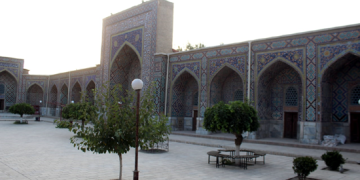NHT Report
Uzbekistan – Samarkand. Khoja Ubaidullah Ahror Wali was born in 1404 (Hijri 806) in the mountain village of Bogistan near the ancient city of Shash (currently Tashkent) Maverannahr. It said that from his father side he was pertained to the first of Chohoryors (First four cylifas, pads of the Prophet Muhammed)-Abu Bakr Siddiq (632-644) and second ?hohoryor-Umar ibn al-Hattob (634-644) from his mother side.
Khoja Ahroriy Valiy takes a special place among the great scholars of wise men of the Muslim world. He studied the ideas put forward to the Sufi waystepers of the Sufi way, and progressively subdue the Tasawwuf method.
He has perfectly mastered the secrets of all kinds of knowledge of Islamic science. The greatness of Khoja Ahror is that his secred character based on Islamic self sacrifice, justice, equity, generosity, stubbornness, poverty and patriotism.
One of the attributes of Khoja Ahror is that he uses the method of “dreaming” in analyzing the facts and phenomena, making conclusions and summarizing their results. In fact, he liked to disclose his findings and impressions as “clear in my dreams”. Therefore he was compared with region and glorified as Khoja Ahror Valiy. The original name of this person was Ubaydullah and the term Ahror is a nickname of a noble meaning. Only three of 356 saints in the history of the Muslim world have been recognized as “Qutb ul-aqtob”. He was the one of these three saints.
During Khoja Ubaydullo’s youthful years in Tashkent, when he was in school, he was fond of books. He respected Abu Bakr Koffol Shoshiy, Sheikh Khovandi Tohur, Sheikh Zayniddin Kuyiorifon-scholars from Tashkent and always visited their graves.
Historical sources say that Khoja Ahror had friendly relations with Timurid princes. He lived in Samarkand for a while, then in Herat. From his works “Risolai Volidia” (Parent Booklet), “Risolai havoriya” (Booklet of fairies), “Faqirot ul ofarin” (The Gospelof Donation) have come to us.
The Holy miracle worker Khoja Ahrar calmed his soul 89 years in 1493 (some historical books indicate the date of death 1489-90) in the town of Kamangaran in Samarkand. His grave is located in the glorious city of Samarkand, with a white marble carved stele. In the cemetery where the spiritual thinker is buried, there are also tombs of great spiritual people.
140 years after the death of Khoja Ahrar Wali, ruler Nadir Divanbegi ordered the construction of a mausoleum in his honor as a sign of reverence and respect for the great spiritual leader. The structure with the image of tigers is painted with patterns and ornaments, carved mosaics are laid out. In the mausoleum there is a winter and summer mosque, an aivan and a tower towering above them, from which at any time of the year the muezzins summon pilgrims who have come from different parts of the world to pour themselves, find peace of mind and their way to the truth.
The last restoration of the Khoja Ahrar Wali Mosque was carried out in the 1990s. The building was recognized as an emergency and it was completely rebuilt by modern architects, the cube was demolished, and instead of one dome, now there are three. In 2003, by the decision of the first President of Uzbekistan, the mosque was rebuilt on the same site using modern methods of construction and decoration. Among the saints especially revered by Muslims of Central Asia and the whole world – Ismail Al-Bukhari, Ahmad Yassawi, Bahauddin Naqshbandi, At-Termezi, Afaq Khoja, Khoja Ahrar occupies an honorable place. Many mysteries and legends are associated with his name.
In 1638, at the revered tomb of the sheikh, by order of Nadir Divanbegi, architect Dostmukhammad built a large madrasah, which was considered the “mirror of Sher Dor”.





